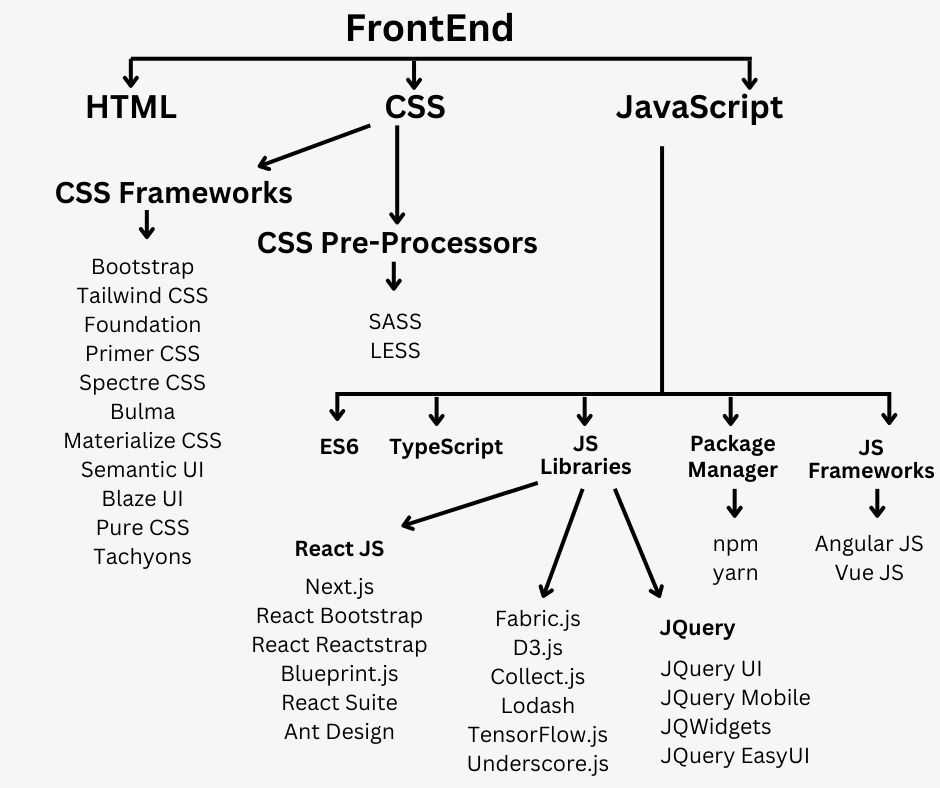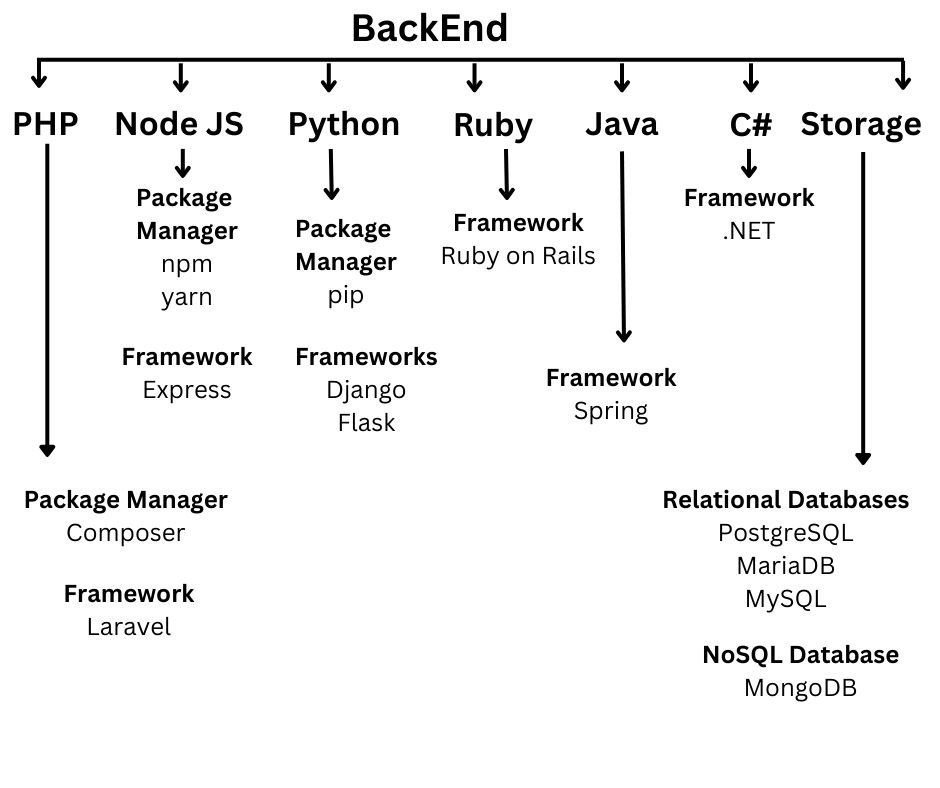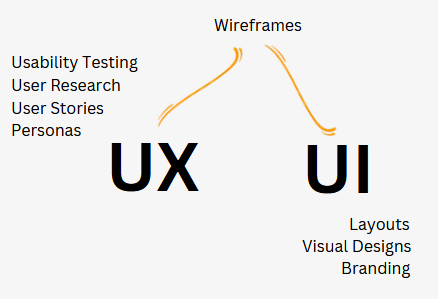Web Development - A Complete Guide
What is Web development? Why should you learn it, where is it used? - Find out answers to all the questions you may have about web development in this blog.
Introduction

Nowadays, where practically every business is looking for its own website and mobile apps, Web developers are in great demand. Owing to the level of impact through their expertise in Computer Science and Web Development, Web developers come under the category of the most highly paid web professionals.
With the increasing number of internet users, it's no surprise that Web Development is a growing industry. The Web Development jobs are expected to increase by 13% by 2030, much faster than most other technology careers.
But what exactly is Web Development? The scope of this comprehensive deep-dive blog on Web Development covers in detail - Web Development and its different types, the Web Development process outlined in a roadmap, and how we can actually become web developers.
What is Web Development?
Web Development is the process of creating and maintaining websites and other internet-searchable applications. It encompasses diverse components such as web design, web programming, publishing, deploying, database administration, and maintenance.
A typical web developer's job is to bring the design and functionality of a website to life by writing code that controls elements like layout, style, and interactivity.
Web developers create everything from static web pages on the internet to E-commerce websites, social networking platforms, content management systems (CMS), and much more. As a result of this, many companies look to hire skilled web developers.
What does a Web Developer do?

Web developers, in general, are in charge of creating and managing websites and applications. The role of web developers involves writing code, identifying and fixing bugs, and interacting with the key stakeholders and designers to ensure that the products they're producing fulfill the needs of both the businesses and their clients.
The exact job of the web developer, however, differs depending on whether they are specialized in Frontend Development, Back end Development, or Full Stack Development. Let us study now - all three different types of Web Development in detail.
Types of Web Development

Frontend Development

Front end Web Development, often known as client-side scripting, encompasses all the aspects of a website that the users directly interact with. Front end developers work on the client-side of the websites i.e, the part of the website where users interact directly.
They help in creating and developing the visual aspects, such as the layout, navigation, graphics, and other aesthetics.
The Front-end is the website's UI (User Interface) and maintains its overall appearance, i.e. how robust and engaging it is. Front end developers must be familiar with nearly all HTML, CSS, and JavaScript principles.
HTML: HTML is an abbreviation for Hyper Text Markup Language. It is used to design the Front end of the web pages using markup language. HTML code acts as a skeleton for a website since it is used to make the structure of a website.
CSS: CSS stands for Cascading Style Sheets and it is used to style our websites. CSS is something we all should look into if we cherish creativity. It allows us to add colors to our website, add borders to the paragraphs, build navigation bars, and experiment with different fonts, text styles, icons, and many other equivalent elements.
Bootstrap is one of the most widely used CSS frameworks for developing responsive, and mobile-first websites.
JavaScript: JavaScript is a scripting language used to provide a dynamic behavior to our website. We must be well-versed with the concepts of DOM and API in JavaScript.
- JavaScript DOM: JavaScript DOM (Document Object Model) is a model in which documents or web pages contain objects (elements, links) that can be manipulated. As a result, you can edit the content of an element, add or delete an attribute, or any combination of these activities.
- Application Programming Interface (API): API stands for Application Programming Interface, and it is a software mediator that allows two applications to communicate with one another. For example: An API is used every time you use an application like Facebook, send an instant message, or check the weather on your phone.
Front-end Frameworks and Libraries:
- AngularJS
- React.js
- VueJS
- JQuery
- Bootstrap
- Material UI
- Tailwind CSS
- Some other libraries and frameworks include: Handlebar.js, Backbone.js, Ember.js etc.
Back end Development

Back end development, often known as server-side scripting, encompasses all the aspects of a website that users can't see and interact with. Back end Web Development is all about what goes behind the scenes that doesn't come in direct contact with the users.
When you engage with a website in some way, such as filling out a form and clicking "submit," the Front end sends this action to the Back end. The Back end then reacts by giving the required information to the Front end - for example, the code needed to show a message such as "Thank you for submitting the form".
Back end Development constitutes some important segments:
- Programming languages: Back end web developers should be skilled in at least one programming language, such as Java, Python, or JavaScript. JavaScript could be a good starting point because it can be used in both the Front-end and Back-end. Nonetheless, you should use the language that best matches your needs.
- Databases: Databases deal with the storage and handling of data. Examples: MongoDB, MySQL, MariaDB, Oracle, SQL Server, etc.
- Server: A server is a system that handles access to data, services, or programs in a network. They are in charge of the data/information exchange between the server and the client.
- Client-Server Architecture: The client-server architecture is designed to comprehend both the request and the response. The server responds to the client's request for data collection whenever such request is made. Following then, a database is involved, which is in charge of storing the information.
Back-end Frameworks:
- Express
- Django
- Rails
- Laravel
- Spring
- Flask
- .NET
Full Stack Development
A Full Stack developer is responsible for both the Front-end and Back-end of a website. These developers can design a website, application, or a software program from start till its deployment.
The term "stack" refers to the several technologies that manage different functionalities on the same website, such as the server, interface, and so on.
Because Full Stack developers require years of expertise in the sector, this position is in high demand. Their broad expertise enables them to improve performance, detect problems before they arise, and assist the other team members in understanding the different components of a web service.
How to become a Web Developer?
Most Web developers, in reality, come from a variety of educational and professional backgrounds; there is no single path to success in this domain.
A Web Development career demands a combination of both hard and soft skills. Many of the required soft skills, such as problem solving, critical thinking, communication, and teamwork, can be transferred from other professions, whereas the hard skills may be learned by Web developers through a structured program or specialized Web Development courses.
The first step towards becoming a Web developer is to comprehend the basic web building blocks: HTML (HyperText Markup Language), CSS, and JavaScript. After you've mastered these languages, you may move on to libraries and frameworks like AngularJS, React.js, Next.js, Node.js etc. At the same time, you must get familiarized with GitHub as well as the text editing tools such as Sublime, VS Code, or Atom.
Building a professional portfolio is another important step on your quest to become a Web developer. Your portfolio highlights particular Web Development projects on which you have worked upon, exhibiting your abilities to potential employers. It should also convey your passion for Web Development and a glimpse of your personality—you can consider it as your personal branding.
It's crucial to understand that you don't need a certain university degree or professional expertise to become a Web developer. You can definitely become a Web developer if you have a strong desire to master the necessary tools and programming languages in this particular domain.
Difference between UX (User Experience) and UI (User Interface)
Although the terms "UX" and "UI" are used interchangeably, there are some significant differences between them. Let's take a look at these differences and see what skills you'll need to master in order to succeed as an outstanding web developer.
User Experience (UX)
The user's experience with a particular system, product, or service is referred to as UX. There are certain skills that you can master to become UX designer:
User RESEARCH
To create a product that meets the demands of the consumer, or to assist the client in achieving a goal, you must first determine who your target audience is. This is the time when you should undertake extensive user research.
User testing should be done as you construct prototypes to maintain track of your web design options. Knowing how to modify your ideas depending on these user-centric stages will help you advance as a UX designer.
WEB design and software skills
To design visual elements, UI and UX designers use design software such as Figma, Photoshop, Sketch, and Illustrator.
Apart from your proficiency in these technologies of Computer Science, you must expand your understanding of visual design components. Typography, layout, color theory, icons, and general design theory are all included.
Communication
UX designers need to have strong communication skills to exchange data and feedback with their team members. In conducting user research, these skills can help the designers get important insights from their clients. Robust communication skills also help the designers to establish trust and interest in stakeholders.
Prototyping, wireframing, and user flow
Visualizing what the design will look like from the user's point of view is an important part of the process. This involves three important elements which are as follows:
- Prototyping: A mock-up, also known as a prototype, is used for testing and gathering initial feedback from the users.
- Wireframing: A wireframe is a 2D design of a page's interface that focuses on content organization, space allocation, and feature positioning.
- User flow: A user flow is essentially a diagram that depicts each step a user takes while using a product or a service.
User Interface (UI)
The user interface (UI) specifies how users can interact with a particular application, product, system, or a service. The web pages must respond whenever the user tries to interact with the pages' components (clicking a button, routing to different web pages, or submitting a form).
A User Interface is the aggregate framing of all items on a web page with which a user interacts. It enhances the overall appearance and usefulness of the website. There are certain skills that you can master to become UI designer:
Interaction design
Interaction design is primarily concerned with how a user interacts with a system. Hence, interactive prototypes are very handy when changing features or elements while tweaking interactions.
Creativity
A user interface designer must build appealing UI designs. To incorporate web design to assist the business goals, the web professionals must comprehend textures, font styles, and color gradients. Many UI Designers gain these skills via hands-on experience with digital interfaces and artistic designs.
Collaboration
As a designer, you will frequently collaborate with other team members. You might work with your authorities to define corporate objectives. Depending on the context and level of development, you may also interact other with user interface (UI) designers to add visual components to a prototype or to code your designs.
Attention to detail
Planning, implementing, and modifying UI systems need meticulous attention to detail. To ensure design quality, you must be able to notice and improve on small but vital components.
Your attention to detail also indicates your ability to analyze and exploit relevant facts for project success. Attention to detail requires good time management and organizational abilities.

Web Development Roadmap
Now that you have understood how a website works and the fundamental differences between Front-end and Back-end programming, let's get started on your Web Development roadmap.
To begin your Web Development journey, you should take a sequence of actions that will lead to the desired conclusion, which is a dynamic and user-friendly website. To get started on a successful Web Development journey, follow the steps below:
Form a plan
Before laying pen to paper or hands to keyboard, it's critical to collaborate first with the teams and employees across your organization to develop a strategy for your website. Here are some questions to think about before creating your first site proposal:
- What is your website's purpose?
- Who is your target audience, and what do you want them to do when they visit your website?
- What kind of website are you creating?
- What kind of content do you want to post, and how frequently?
- How would you design your website to provide the finest navigation experience?
- What is your cash flow? (Budget of building your website)
Select a technology (write your website code)
Full Stack Development includes Front end development, Back end development, and database administration. Below are couple of trending technologies that you can choose for building your websites:
-
MERN: MERN is perhaps the most popular and well-known technology. The four letters stand for the four technologies listed below.
- MongoDB: MongoDB is used for high-volume data storage and it is a document-oriented NoSQL database.
- Express.js: Express is a node.js web application framework that offers a variety of functionalities for developing mobile and web applications. It can handle GET, PUT, POST, and DELETE requests.
- React.js: React is a JavaScript library that is used to create user interfaces and single-page web applications.
- Node.js: Node.js is an open-source development platform for running JavaScript code on the server. NodeJS is useful for developing real-time apps that require a persistent connection from the browser to the server.
- MEAN: The main difference between MERN and MEAN is that MERN works with React, whereas MEAN works with Angular (a framework written in TypeScript).
Build front end of your website
Front end development is crucial since it is what your visitors, clients, and users will see and how they will interact with your website.
Front end developers must be familiar with nearly all HTML, CSS (Cascading style sheets), and JavaScript principles. Front end web developers also manage typography, fonts, navigation, placement, browser compatibility, and responsiveness. This part will reflect on your initial site vision and what you included in your wireframe.
Build back end of your website
The data that supports the functionality on the Front-end is handled by the Back-end. It consists of two major components:
- Databases: Databases are in charge of storing, organizing, and processing data so that it can be retrieved by the server requests.
- Servers: A server is a system that handles access to data, services, or programs in a network. They are in charge of the data/information exchange between the server and the client.
These elements are combined to build the foundation of each website. Backend developers will establish three things while constructing your website:
- Your logic code, which is a collection of rules that govern how your website responds to certain requests and how its objects interact.
- Your database administration, which is how your website's data will be organized, managed, and retrieved.
- Your infrastructure, which will host your website. Hosting your own site gives you more control, but it is far more expensive and necessitates your own server health and security.
Version control
If you are working on web applications, using Git & GitHub is a good practice. Git is an open-source platform where the entire code is available from the start. It is secure, adaptable, easy to change, and enables code restoration. Anyone can collaborate on it and make changes to the code.
There are certain version control platforms including GitHub, GitLab, Beanstalk, Mercurial, and Apache Subversion.
Acquire a domain name
Your website will now be assigned an IP address. It also requires a domain name, which is a memorable website name that visitors may use to discover your website.
You've probably heard of GoDaddy and Hover. These services assist you in purchasing a domain name and registering it with ICANN (Internet Corporation for Assigned Names and Numbers). Most domain registrations are valid for a year before they are required to be renewed.
Domain names may also be purchased through website builders and hosting providers such as WordPress and Squarespace.
Launch your website
When you've registered a domain name and linked it to your host, you're almost ready to publish your work on the internet.
But wait a minute — there are a few things you'll need to double-check before the official launch. These include planning out responsibilities on your team, extensively testing your site for bugs, optimizing for SEO (Search Engine Optimization), and doing a last check before "turning the switch" and bringing your site live.
What is the average time it takes for a Web developer to build a website?
Interactive and dynamic websites that appear to be simple from outside, can actually take much more time to develop for web developers. The technical abilities of the web developers, the technologies and programming languages necessary to create websites, and the features to be included in the website may all have an impact on the time and cost for developing a website. Usually, a custom website typically takes around 3 months from start to its deployment.
There are various phases involved to create websites which are as following:
- Discovery Phase (Specifications & Requirements)
- WEB DESIGN PHASE
- Development Phase (Coding)
- Testing & Debugging
- Deployment, Migration, and Maintenance
What is the cost of building a website?
The cost of creating and developing a website varies depending on whether you hire web developers or a professional Web Development company.
Depending on your preferences and the features you want in your website, the cost might range from $200 to $1,00,000.
Domain registration, hosting services, SSL certificates, website templates, styling, and website content can all cost money, either directly or indirectly.
Conclusion
As discussed above as well, It's important to understand that you don't need a certain university degree or professional expertise to become a Web developer. We hope you have gained extensive and complete knowledge of the Web Development road map.
This deep-dive blog has shed light on the Full Stack Web Developer roadmap, which includes Front-end and Back-end Development for aspiring web developers.
The need for web designers and developers is at an all-time high. The number of users on Internet globally is more than 5 billion and hence, digitizing and advertising the business online is in high demand.
Online presence for a business is now almost mandatory. You can hire a Full Stack Developer to create a website for you and establish your brand worldwide. You can get features-rich, user-centric, and business-objective-oriented website for your personal/professional use.
However, you must also prepare yourself, master Web Development skills through Web Development tutorials and have the knowledge to assist businesses in building a distinct online presence. Because of the competitive nature of the market, business websites must understand the behavior of customers and should be built in such a way that people choose to purchase from that firm. Here is where web developers can make a significant difference.
If you are passionate about designing websites (with responsive design) and online apps or working on UI/UX, Web Development could prove to be a terrific profession.
However, as it's a domain that is always evolving, you must constantly enhance your abilities to stay consistent with the new technologies and frameworks.
